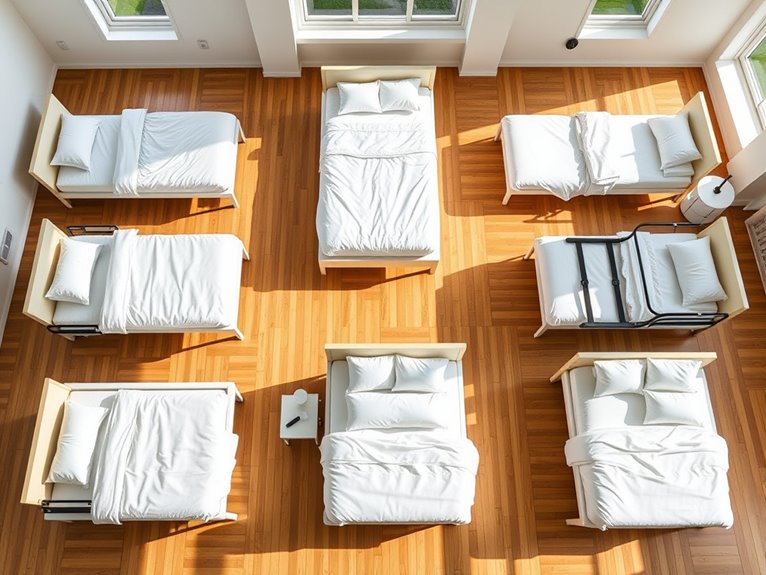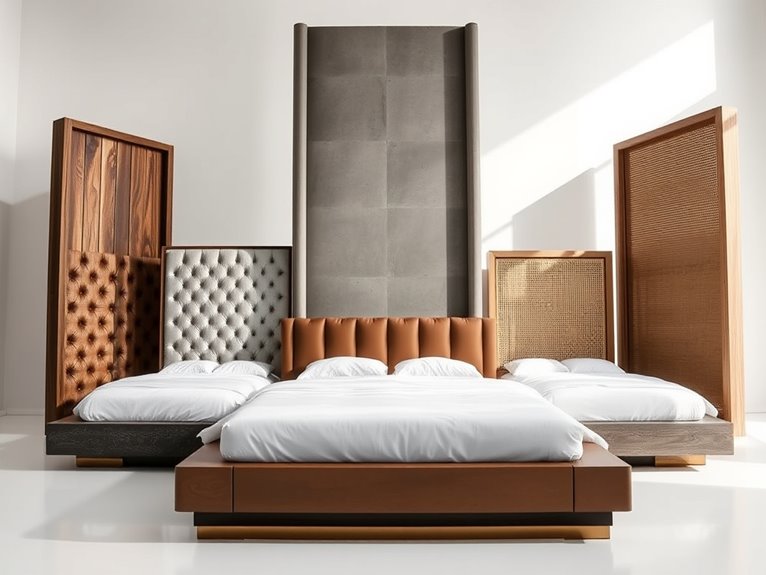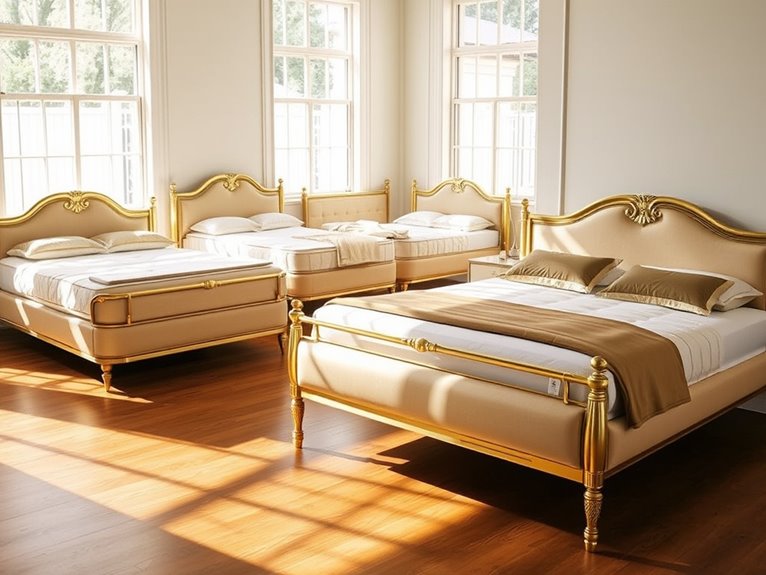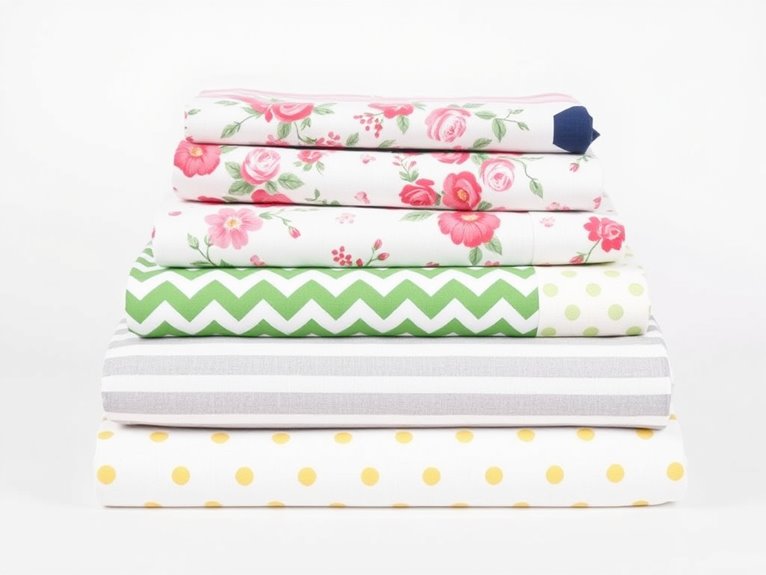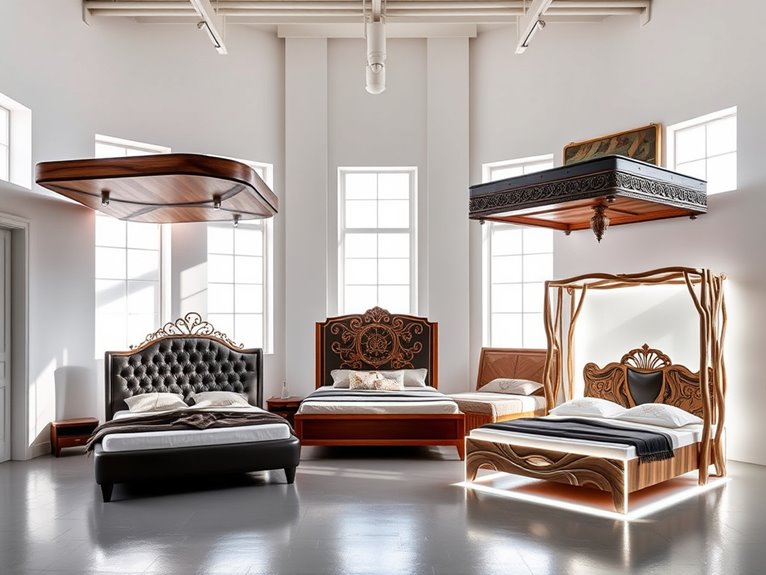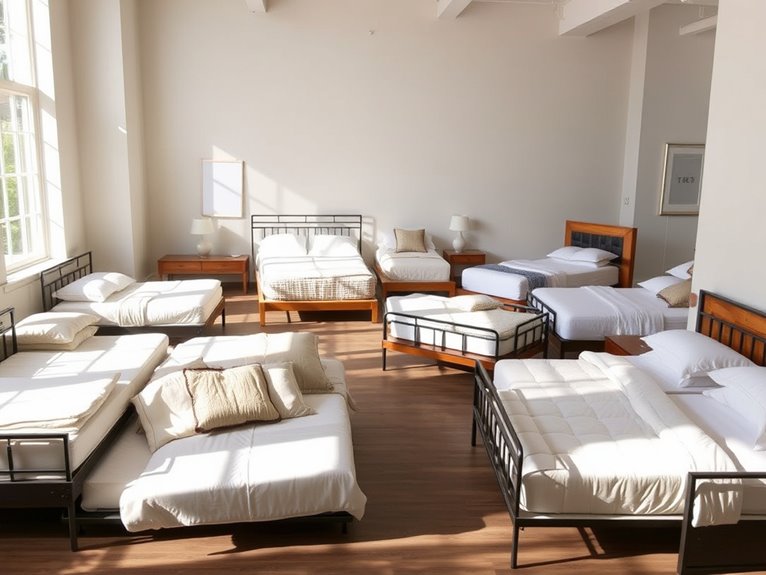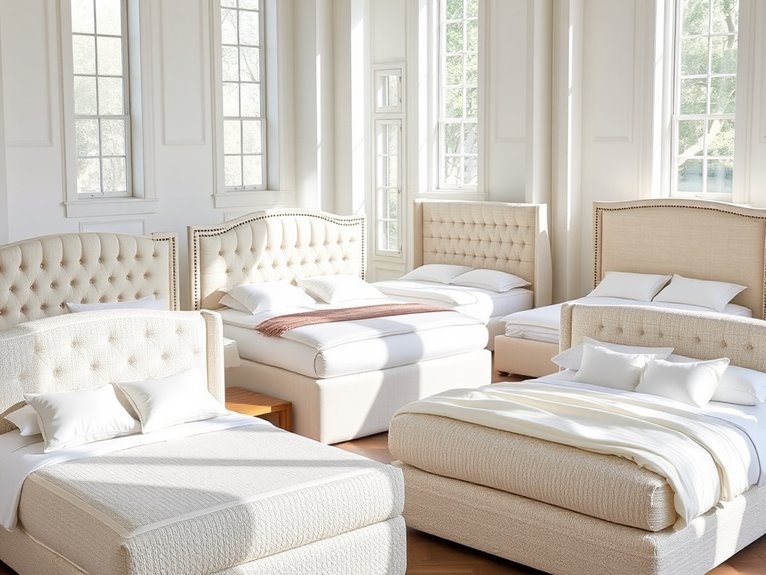6 Accessible Bed Designs
You’ll discover that accessible bed designs have evolved far beyond basic functionality, blending seamless practicality with modern aesthetics. From sleek electric frames that adjust at the touch of a button to innovative platform designs that make transfers effortless, today’s options prioritize both independence and style. Whether you’re seeking built-in safety features or prefer a minimalist floor-level approach, these six thoughtfully engineered solutions combine comfort, convenience, and contemporary design in ways you never imagined possible.
Electric Height-Adjustable Beds
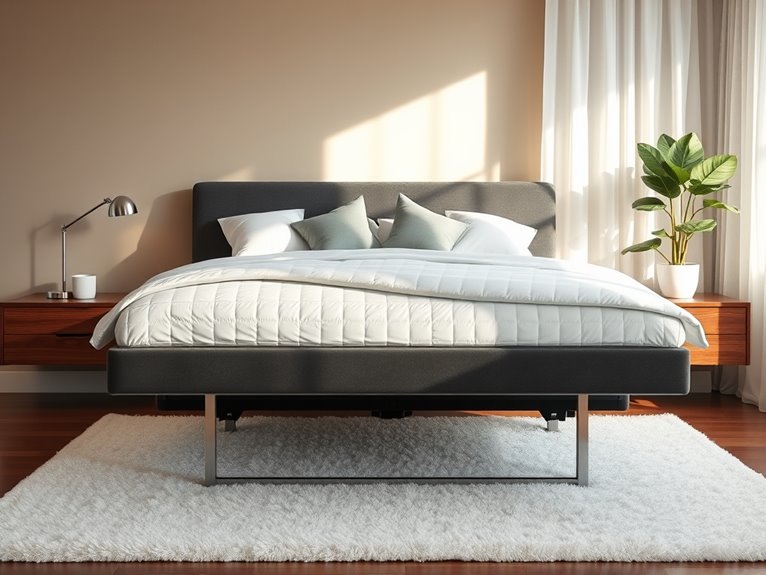
Electric height-adjustable beds combine sophisticated functionality with modern aesthetics, creating a sleek and adaptable centerpiece for any bedroom. The clean lines and minimalist design of these beds allow them to seamlessly integrate into various interior styles, from contemporary to transitional. The ability to adjust the bed’s height not only serves practical purposes but also creates visual interest through its dynamic nature.
This bed style particularly excels in universal design applications and modern bedrooms where functionality meets style. The adjustable feature makes it ideal for year-round use, while the typically neutral finishes and streamlined appearance work well with any seasonal décor changes. These beds are especially effective in spaces where accessibility needs to merge with sophisticated design elements.
Essential Components:
- Electric adjustable bed frame with remote control
- Memory foam or hybrid mattress
- Moisture-wicking fitted sheet
- Flat sheet
- Duvet or comforter
- 2-4 sleeping pillows
- 2-3 decorative pillows
- Side rails (if needed)
- Headboard (optional)
- Bed skirt or platform covering
- Cable management system
- Backup battery system
How to Achieve This Look
The foundation begins with selecting an electric height-adjustable frame in a finish that complements your room’s color scheme. Choose neutral tones like graphite, silver, or white for versatility.
Install the frame according to manufacturer specifications, ensuring all electrical components are properly connected and concealed.
Layer the bed with high-quality bedding that enhances both comfort and style. Start with a fitted sheet that accommodates the bed’s movement, followed by a flat sheet and duvet. Select bedding in solid colors or subtle patterns that won’t compete with the bed’s technological features.
Colors like slate gray, warm white, or sage green create a sophisticated palette. Complete the look with carefully chosen accessories that won’t interfere with the bed’s functionality.
Position decorative pillows so they can be easily removed when adjusting the bed’s height. Consider incorporating a mounted headboard that moves with the bed frame, using materials like upholstered panels or sleek wood finishes that complement the modern aesthetic.
Pro Styling Tips
Keep essential controls accessible but discreet by using bedside organizers or hidden compartments. For smaller rooms, choose a frame with under-bed storage capabilities to maximize space.
Maintain the bed’s clean lines by regularly checking and tucking cables, and consider using breakaway connectors for safety. For seasonal updates, swap out duvet covers and decorative pillows while maintaining the bed’s core neutral palette.
Install motion-sensor under-bed lighting to enhance both functionality and ambiance.
Transfer-Friendly Platform Designs
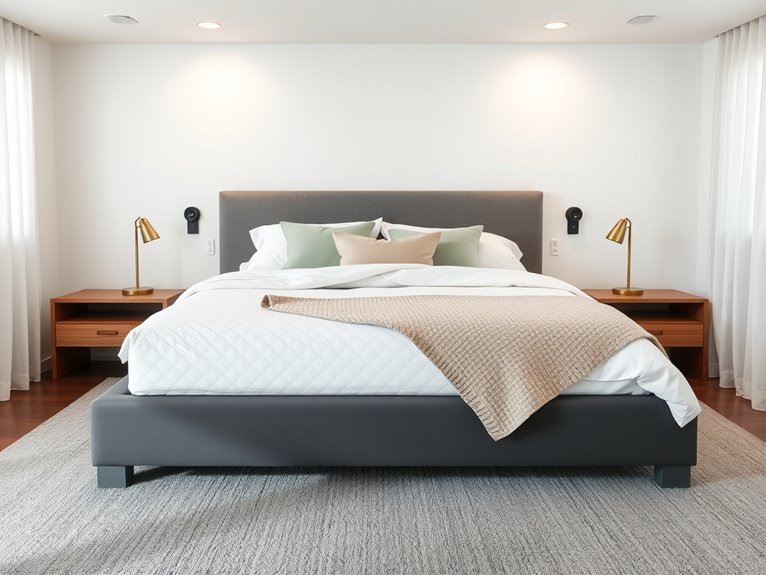
Transfer-Friendly Platform Designs combine functionality with modern aesthetics, featuring clean lines and a minimalist approach that makes the bed both accessible and visually striking.
The low-profile platform creates an architectural statement while maintaining a sleek, uncluttered appearance that works particularly well in contemporary and transitional bedroom designs. The intentional spacing around the bed and simplified bedding arrangement ensures easy access from multiple angles.
This design technique proves especially effective for universal design principles and adaptive living spaces, while still maintaining high-end hotel-like sophistication. The style works year-round and can be easily modified with seasonal textiles, making it particularly suitable for master bedrooms, guest rooms, and assisted living spaces where both style and accessibility are priorities.
Essential Components:
- Platform bed frame (18-24 inches height)
- Firm mattress
- Fitted sheet
- Flat sheet
- Lightweight duvet or coverlet
- 2-4 sleeping pillows
- 2-3 decorative pillows
- Side tables at mattress height
- Non-slip floor mat
- Transfer pole or grab bar (if needed)
- Motion-sensor night lights
How to Achieve This Look
Begin by positioning the platform bed with equal clearance on both sides, ideally 36 inches for optimal transfer space. Install the fitted sheet with hospital corners to maintain a smooth surface, essential for easy movement.
The flat sheet should be tucked loosely at the foot of the bed while remaining free at the sides to prevent restriction during transfers.
Layer the bed with a lightweight duvet or coverlet, folded back approximately one-third of the way from the head of the bed. This creates a clean line while keeping the transfer zones clear.
Choose bedding in solid colors or subtle patterns to minimize visual distraction and maintain the calm, organized aesthetic.
Select pillows that provide both function and style – two standard sleeping pillows in crisp white cases, complemented by decorative pillows in coordinating colors. Position decorative elements away from transfer zones, typically centered on the bed or towards the headboard.
Optimal color combinations include neutral bases like grey, taupe, or white with subtle accent colors like sage green, navy, or soft gold.
Pro Styling Tips:
Layer textures rather than patterns to add visual interest while maintaining functionality – think ribbed throws, quilted coverlets, or textured pillow cases in monochromatic schemes.
For smaller rooms, choose platform beds with built-in storage to maximize space while maintaining the clean aesthetic. Keep seasonal adjustments simple by switching out decorative pillows and throws rather than changing the entire bedding ensemble.
Consider using performance fabrics that resist wrinkles and maintain their appearance despite frequent handling and adjustment.
Built-In Support Rail Systems
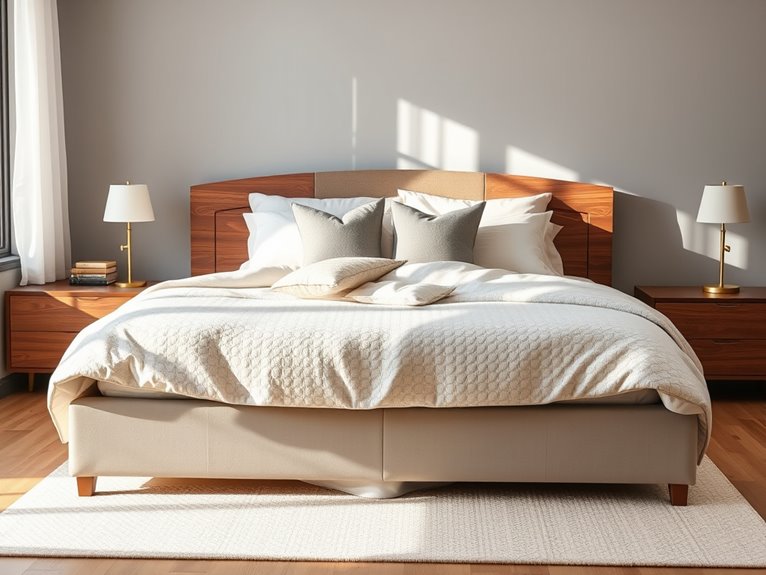
Built-In Support Rail Systems combine functionality with elegant design, creating a seamless look that enhances both safety and aesthetics in the bedroom. These integrated rails, typically finished in matching wood tones or powder-coated metals, appear as intentional design elements rather than medical additions, making them particularly appealing for those seeking assisted mobility without compromising style.
The thoughtful integration of these support systems allows them to blend naturally with the bed’s overall architecture, often incorporating curved lines and sophisticated finishes that complement various décor styles. This design approach works exceptionally well in contemporary and transitional bedroom settings, where clean lines and purposeful features are celebrated.
Built-in rails prove particularly valuable for aging-in-place designs or multi-generational homes, offering practical support while maintaining a high-end residential appearance. The versatility of these systems makes them suitable year-round, with the ability to accommodate seasonal bedding changes and style updates without compromising functionality.
Essential Components:
- Integrated bed frame with built-in rail system
- Reinforced mounting brackets
- Matching headboard and footboard
- Support rail covers or sleeves
- Anti-slip rail grips
- Decorative end caps
- Coordinating bedding ensemble
- Mattress with compatible height
- Support rail locking mechanisms
- Accent pillows
- Bed skirt or platform cover
- Safety compliance documentation
How to Achieve This Look
The foundation begins with selecting a bed frame specifically designed with integrated rails. Choose a finish that complements your existing furniture, considering options like warm woods for traditional spaces or brushed metals for contemporary rooms. The rails should be positioned at the optimal height for easy gripping while seated or lying down, typically 18-22 inches above the mattress surface.
Focus on creating a cohesive look by coordinating the rail system with your bedding choices. Layer the bed with high-quality linens that drape elegantly around the rails without interfering with their function. Consider using split duvets or modified bed skirts designed to accommodate the rail system while maintaining a polished appearance.
Color schemes should be chosen to minimize the visual impact of the rails. Natural tones like warm grays, soft browns, or muted blues help integrate the support features into the overall design. When photographing the setup, capture angles that showcase how the rails complement the bed’s design rather than dominate it. Use soft, diffused lighting to highlight the bed’s architectural elements while minimizing any utilitarian aspects of the support system.
Pro Styling Tips:
For a designer-approved approach, use textural elements like woven throws and decorative pillows to soften the appearance of the rails while maintaining their accessibility. Adapt the look seasonally by changing accent pieces and bedding weights, always ensuring clear rail access.
Consider using quick-release mechanisms for bedding around the rails to simplify daily bed-making while preserving the styled appearance. For smaller rooms, choose rails with a slimmer profile and utilize vertical space with taller headboards to maintain proportion while maximizing functionality.
Zero-Clearance Floor Beds
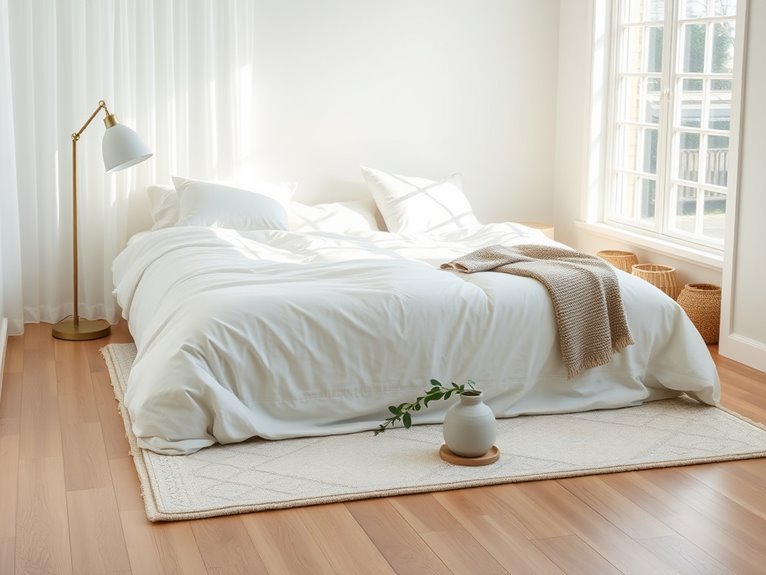
A zero-clearance floor bed creates a grounded, serene aesthetic that transforms any bedroom into a modern sanctuary. This minimalist approach eliminates the traditional bed frame entirely, placing the mattress directly on the floor or on an ultra-low platform that appears to float just above the ground.
The design creates clean lines and an uncluttered appearance while making the ceiling appear higher, lending an expansive feel to the space. This styling technique works particularly well in contemporary, Japanese-inspired, or minimalist interiors, especially in rooms with limited square footage.
The low-profile design proves ideal for loft spaces, rooms with sloped ceilings, or anywhere you want to create a casual, laid-back atmosphere. Zero-clearance beds are particularly appealing during warm seasons when a closer connection to the ground provides natural cooling, though they can be styled year-round with appropriate bedding layers.
Essential Components:
- High-quality mattress
- Moisture-barrier mat or tatami
- Low-profile box spring (optional)
- Fitted sheet
- Flat sheet
- Duvet or comforter
- 2-4 sleeping pillows
- 2-3 decorative pillows
- Floor cushions
- Area rug
- Bedside floor lamps
- Storage baskets
How to Achieve This Look
Begin by selecting an appropriate location, ensuring the floor is clean and level. Place a moisture-barrier mat or traditional tatami beneath the mattress to protect it from floor dampness and provide proper ventilation.
Position the mattress deliberately, typically centered on the wall but allowing for asymmetrical placement in larger rooms. Layer the bedding starting with crisp, high-quality sheets in neutral tones like ivory, gray, or soft white.
Add visual interest through texture rather than pattern, incorporating natural materials like linen, cotton, and wool. The duvet or comforter should be slightly oversized to create elegant draping that cascades to the floor, softening the mattress’s sharp edges.
For color harmony, work with a restricted palette of two to three complementary colors. Earth tones, cool grays, and warm whites create a sophisticated foundation, while accent pieces can introduce muted blues, soft greens, or pale terracotta.
When photographing the style, capture angles that emphasize the horizontal lines and the interplay between the bed and floor plane.
Pro Styling Tips
Keep the surrounding floor space clear of clutter by incorporating hidden storage solutions like rolling drawers that slide underneath the mattress. Adapt the look seasonally by switching between light, breathable cotton layers in summer and plush, layered textiles in winter.
For daily maintenance, invest in a handheld vacuum for easy cleaning around and under the mattress, and rotate the mattress quarterly to ensure even wear. Consider using a folding screen or room divider to create a sense of enclosure while maintaining the bed’s low profile.
Articulating Base Frames
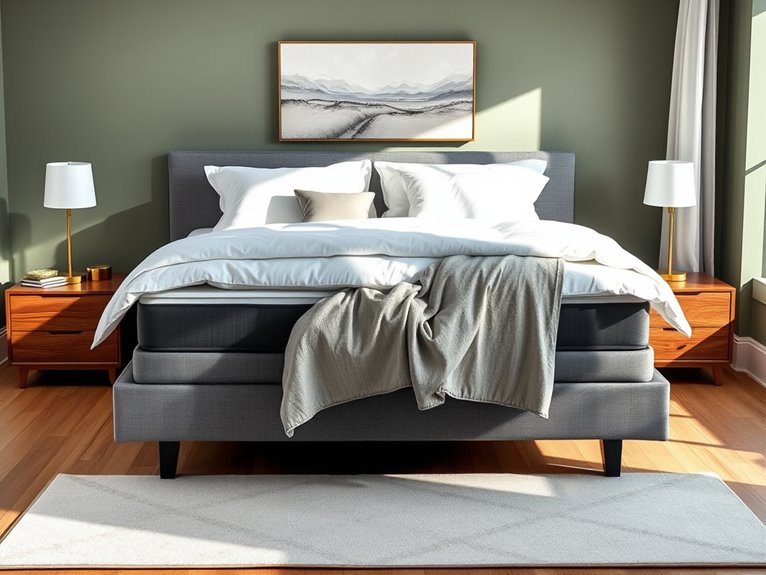
Articulating base frames represent the perfect fusion of modern technology and ergonomic comfort in bedroom design. These adjustable foundations allow customizable positioning of the head, foot, and sometimes lumbar areas, creating an aesthetically sophisticated profile that elevates any bedroom’s visual appeal.
The clean lines and contemporary styling of articulating frames complement both modern and traditional décor while offering unparalleled functionality. This innovative bed styling technique works particularly well in master bedrooms, guest suites, and spaces designed for optimal comfort and accessibility.
The versatility of articulating bases makes them suitable year-round, though their ability to create an elevated headrest is especially valuable during seasons when allergies or respiratory issues are common. The style adapts seamlessly to various interior design themes, from minimalist contemporary to luxurious hotel-inspired spaces.
Essential Components:
- Articulating base frame with remote control
- Memory foam or hybrid mattress
- Fitted sheet with deep pockets
- Flat sheet
- Duvet or comforter
- Decorative pillows (4-6)
- Bed skirt or platform cover
- Lumbar support pillows
- Side table or wall-mounted shelf
- USB charging cables
- Cord management solutions
How to Achieve This Look
Start by selecting an articulating base that complements your room’s style and offers the desired adjustment features. Position the frame centered in the room, ensuring adequate clearance for all movements.
Install a compatible mattress that’s designed to flex with the base’s articulation while maintaining its shape and support. Layer the bed with high-quality bedding that accommodates movement. Deep-pocket fitted sheets are essential, as standard sheets may pop off during adjustments.
Choose materials that drape well and maintain their appearance in various positions – silk, high-thread-count cotton, or performance fabrics work best. Neutral colors like ivory, gray, or navy provide a sophisticated foundation.
Create a polished look by incorporating structured pillows that maintain their shape when the head section is raised. Arrange larger pillows against the headboard, followed by standard pillows and smaller accent pillows.
Use throws or blankets that can be easily adjusted as the bed position changes, folding them in a way that allows for movement without losing their decorative appeal.
Pro Styling Tips:
For a seamless look, choose a bed skirt with extra length and pleating to accommodate various positions without revealing the mechanism underneath. In smaller rooms, opt for a platform-style base with built-in storage to maximize space efficiency.
Keep the remote accessible but concealed in a stylish holder or drawer, and regularly adjust the bedding to prevent bunching or wrinkles from repeated position changes.
Consider using mattress holders or straps to keep bedding secure during adjustments, especially with silkier fabrics that tend to slide.
Side-Access Specialty Beds
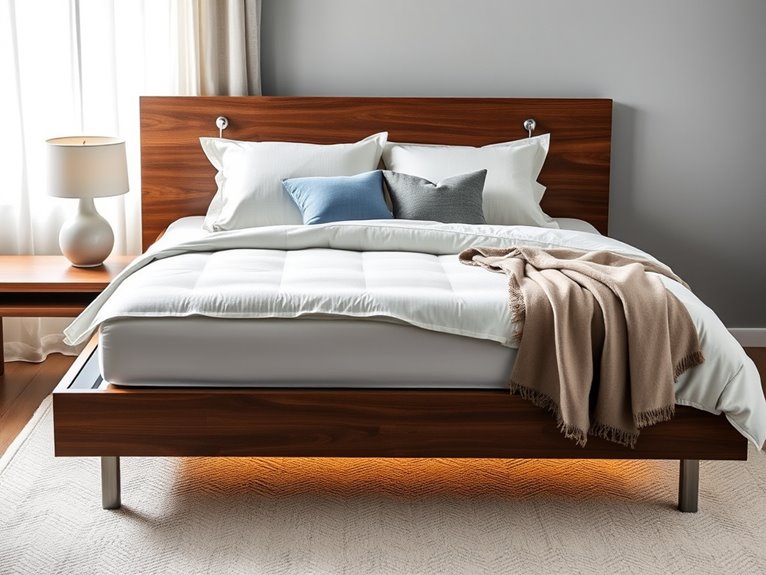
Side-access specialty beds represent an innovative approach to bedroom design that prioritizes both functionality and aesthetics. These beds feature extended clearance on one or both sides, with specially configured frames and support systems that allow easy lateral access.
The visual appeal comes from their clean lines, purposeful design elements, and the way they create an open, uncluttered look in the bedroom while maintaining a sophisticated appearance. This bed styling technique proves particularly valuable in medical care settings, assisted living spaces, or for individuals with mobility considerations.
The design works well year-round and adapts beautifully to various interior styles, from modern minimalist to traditional comfort. The key is focusing on layers of soft, durable materials while keeping the bed’s practical access points clear and inviting.
Essential Components:
- Adjustable bed frame with side-access features
- Extra-firm mattress with reinforced edges
- Split-side fitted sheets
- Zip-on pillowcases
- Quarter-fold flat sheets
- Slide sheets or transfer aids
- Decorative bolsters
- Removable bed rails
- Easy-grip handles
- Moisture-resistant mattress protector
- Lightweight duvet
- Non-slip floor mats
How to Achieve This Look
Position the bed frame against a wall, leaving ample clearance on the access side. Install any necessary support rails or handles in coordinating finishes that complement the room‘s hardware.
Select bedding in breathable, durable fabrics that can withstand frequent adjustments while maintaining their appearance. Layer the bed starting with a high-quality mattress protector, followed by fitted sheets designed for easy changes.
Opt for bedding in solid colors or subtle patterns that won’t overwhelm the space. Neutral tones like soft grays, warm beiges, or gentle blues create a calming atmosphere while disguising any practical elements.
Choose decorative elements that enhance both function and style. Position bolster pillows to provide support while adding visual interest. Incorporate throws and accent pillows that can be easily removed and replaced.
When photographing the space, capture angles that highlight both the bed’s accessibility features and its aesthetic appeal.
Pro Styling Tips
Incorporate quick-release fasteners on decorative elements for easy removal during care routines. Scale your decorative choices to the room size – smaller spaces benefit from lighter colors and fewer accessories, while larger rooms can handle more substantial pieces.
For seasonal updates, swap out pillow covers and throws while maintaining the core functional elements. Use washable fabrics in dark or medium tones for high-touch areas to ensure the bed maintains its polished appearance despite daily use.
Consider installing under-bed lighting for both ambiance and practical nighttime visibility.
